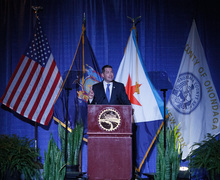How Syracuse University has improved the student veteran experience under Kent Syverud
Son Tuyen Huynh | Contributing Illustrator
When Mike Haynie thinks about how improving the student veteran experience at Syracuse University could benefit the student body as a whole, he remembers one encounter with a 26-year-old student veteran.
Three weeks before he came to SU as an academic freshman, the veteran had been a sergeant and a squad leader in the 10th Mountain Division at Fort Drum. In the weeks before the semester began, he was informed by SU Housing that he had been mistakenly placed in a freshman dorm with an 18-year-old roommate. Housing told him he could live in graduate student housing instead, but the veteran declined, to Haynie’s surprise.
“And he said, ‘You know, the Army taught me how to lead 18-year-olds, I figured I could lead 18-year-olds at Syracuse University, too,’” said Haynie, SU’s vice chancellor for veterans and military affairs.
It’s the kind of thing that gives you goose bumps when you hear it, Haynie said, but that story is a good example of what Haynie and other SU administrators view as essentially the ripple effect of having student veterans on campus — veterans who can be leaders, present teachable moments and be positive influences on other SU students.
It’s one of the reasons why when he delivered his inaugural address as the new head of SU in 2014, Chancellor Kent Syverud made advancing veterans affairs at SU one of his four top goals for the university moving forward into the next decade. He said then that SU “must once again become the best place for veterans.”

Jordana Rubin | Digital Design Editor
And now, in 2016, Syverud said he would argue that the university is there. Maybe not in every niche, he said, and maybe not in every ranking, but perhaps in research funding, enrollment, student quality and student diversity and inclusiveness.
“I think if we’re known for this — as I think we should be — I think the goodwill toward people who are associated with Syracuse will be extraordinary, could be a network of support across a lifetime that would be very meaningful,” Syverud said.
Syverud’s focus on building veterans programs at SU is something Haynie said creates opportunity for the whole of SU, not just for veterans or military-connected students, but for the university’s research programs, academic programs and non-veteran students in the classroom.
Veterans don’t go to college or get an education the same way that traditional students do, Syverud said, so serving a diverse veterans population at SU would mean that the university could learn a lot about how to serve “what is increasingly” going to be its entire student population — students who don’t go to college directly from high school, students who don’t move linearly through four semesters, students who change their majors and fields.
“If we can tailor programs that work well for veterans to all our students, then all our students are going to get a better experience here,” Syverud said. “Right now, it’s incredible when I go around Syracuse what a large fraction of our students are not the traditional student that our faculty often assumes.”
The student experience at SU, Syverud said, is enhanced by having a range of people in the classroom, and the veteran experience is “pretty unique and is pretty underrepresented at elite universities in the United States.”
Veterans are non-traditional students, Haynie said, as more than 50 percent of student veterans are married, he said, and of that group, 50 percent have at least one young child at home.
Traditional colleges and universities, he added, haven’t necessarily established flexibility that aligns with non-traditional students — something Haynie thinks they have a responsibility and an opportunity to do, considering many Post-ç G.I. Bill veterans chose military service because it was a pathway to an education that they would have otherwise not have had access to.
From an academic perspective, the student veteran population at SU can show the university community what disruption means in the lifespan, Provost-Designate Michele Wheatly said, whether that disruption is a disability or a decision to change one’s major. When SU students see that disruption through the eyes of student veterans, Wheatly said those students could learn how to bounce forward from interruption — an opportunity she said will be great for all SU students.

Jordana Rubin | Digital Design Editor
Recently elected Student Veterans Organization (SVO) President John Miccio, a first-semester junior information management and technology major who spent six years in the U.S. Army, said he was surprised upon coming to SU to see how little non-veterans are involved in veterans affairs, which can also translate to the classroom.
“At least what I’ve personally noticed, a lot of the students look at us like the red-headed stepchildren a lot of times,” Miccio said. “I go to a class and it’s just like I’m the old guy in the class. It’s different.”
Miccio added that it’s not necessary to be a veteran to be part of SVO, yet there are only two non-veteran SVO members out of 68 active members.
Bridging that gap and getting more non-veterans involved in SVO is one of Miccio’s goals for the coming year as SVO president. But he sees another gap in veterans affairs at SU — one between ROTC cadets and student veterans.
A potential solution to bridge that gap, Miccio said, is the National Veterans Resource Complex, one of the biggest veterans initiatives that has emerged under the leadership of Syverud. The NVRC would encompass all of SU’s veterans initiatives in one building, and help bring together ROTC, which is headquartered in Archbold Gymnasium, and the SVO, which is currently centered in University College.
“Because since we’re so separated, they’re not asking us questions,” Miccio said. “It would probably benefit them a lot to speak to veterans that have done it. But they just don’t know us because we’re so separate.”
The NVRC is a “big step,” Miccio added, and he’s excited to be on campus when it’s built.
Syverud said he sees the NVRC as a method of combining “an array of programs that are outward-facing to the community” and “inward-facing to the university.” In the NVRC he includes ROTC, programs that help military personnel transition to civilian life and research programs.
Haynie said there is a significant opportunity at SU to leverage veterans affairs in order to build new opportunity for students and faculty on the research side. Due to the university’s work related to veterans both nationally and campus-wide, Haynie said SU has been able to build relationships rooted in research with the U.S. Department of Veterans Affairs and the U.S. Department of Defense.
But aside from expanding upon an opportunity in prioritizing veterans affairs, SU has, under the leadership of Syverud, tried to become the best place for veterans. Many veterans who are first-generation college students are afraid of not being welcomed and not fitting into a traditional college or university setting, Haynie said, and Syverud has emphasized that SU cannot let that happen.
“I think having a university that is as welcoming to people from around the world and from all socioeconomic groups and races and genders and gender identities is further enhanced by having a university that has as part of the component people who serve the country in public service and in the military,” Syverud said.
Published on April 25, 2016 at 10:42 pm
Contact Alexa: atorrens@syr.edu







